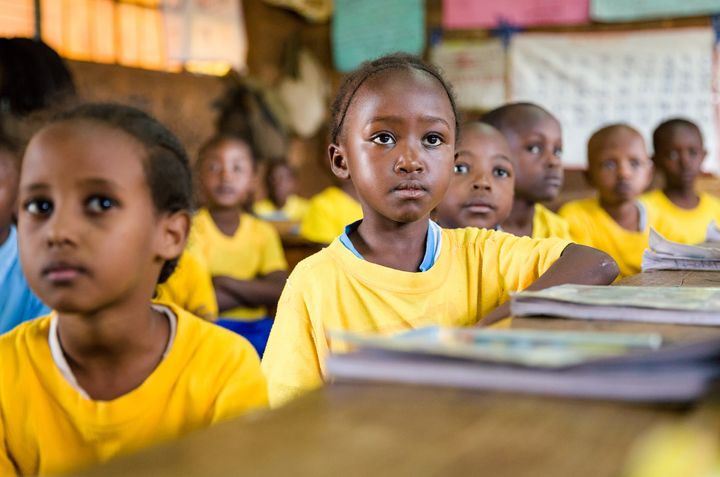
Students in second grade classroom. at Nyamachaki Primary School, Nyeri County, Kenya.
Between 2001 and 2016, the number of children in school around the world rose by 243 million, or approximately 20 percent. This is fantastic news. Tens of millions of more children today have access to a basic education and many of these are learning and will have brighter futures.
However, despite this very positive increase, there are still too many of these children who are not learning enough, especially the poorest.
Dismal education quality means that only half of all primary school children in developing countries are on track to acquire basic reading and math skills.
At secondary school level, only a quarter of students are on track to meet minimum learning standards. Three fourths of children failing to meet basic reading and math skills are actually attending school.
On top of the learning challenge, rapid population growth means that improving education outcomes will continue to be an uphill struggle, especially in sub- Saharan Africa. Without radical progress, by 2030 over 825 million young people will not have the basic secondary school skills needed to get a job.
We know what works
While this challenge keeps me awake at night, we know what is needed to deliver quality education for all. At the Global Partnership for Education (GPE), learning quality is our number one priority. We are working with more than 60 developing countries to improve planning, invest in teaching and curricula, and measure learning – essential pieces in building resilient education systems that can deliver quality at scale, leaving no child behind.
A major challenge is the lack of data. Nearly a third of GPE’s developing country partners had no large-scale learning assessment system in place by 2015. To provide a safe, quality learning environment staffed with qualified teachers and appropriate learning materials, our country partners first need much better data regarding their student populations and learning needs.
Therefore, our strategy is two-fold: first to improve learning data collection and use, and then invest in what we know will improve the teaching-learning process between students and teachers.
Allow me here a shout-out for teachers. We can pump technology and monitoring processes into schools, but at the heart of learning is the human interaction between qualified, trusted teachers and individual children. It is critical that we place increased support to teachers – for their training and essential materials – at the center of our work.
There is no one-size fits all approach
Local context is also enormously important. South Sudan, coming out of decades of conflict with very low investment in education has very different needs from Ethiopia or Kenya, long standing GPE partners with large and complex, but less fragile education environments.
However, with support from GPE, all partner countries are investing in teaching and learning. Of the 41 active GPE grantees in July 2017, 98 percent invested in teachers’ professional development, 85 percent in learning materials and 70 percent in learning assessment systems.
To maintain focus on outcomes, not processes, disbursement of 30 percent of GPE funding for a country is linked to results, including gains in learning. This is helping to shift national dialogues and ensure that investments move beyond school construction and enrollments to the quality of the interaction between teachers and students. To qualify for GPE grants, developing countries themselves must also commit to increasing their own education spending.
In the Democratic Republic of Congo, where less than half of all fourth graders cannot read a single word, 30 percent of a $100 million GPE grant is dependent on the country meeting agreed learning and equity results, especially in reading.
In Kenya, GPE is supporting a numeracy drive, including training of 95,000 teachers in new methods of math teaching, and purchasing and distributing more than 2.3 million new textbooks.
Rwanda is administering large-scale learning assessments for the first time while Nepal is conducting early grade reading assessments with parental involvement.
Support for education from global leaders
Leaders around the world are also stepping up to the education challenge. They include Peter Mutharika, the President of Malawi, who describes quality education as ‘a moral imperative’.
President Emmanuel Macron of France and President Macky Sall of Senegal will co-host GPE’s Global Education Financing Conference in Dakar, Senegal in early February – a pivotal test of global commitment to education financing.
Malala Yousafzai continues to inspire, advocate and demand the right to education for girls all over the world.
Educating every child is an investment that delivers societal benefits that are impossible to overstate. Yet, as any education leader can tell you, putting the systems in place to deliver safe, high quality education is a complex, long-term commitment.
Quality education for all is not beyond us. However, tt requires good planning, better data, a rigorous focus on outcomes and adequate financing.
2018 will test the political commitment to quality education and SDG4 as we seek to translate it into tangible action and increased investment. As we contemplate the year ahead, I sincerely hope that our global and national leaders will respond to the opportunity before us to support education, increased skills, economic growth, peace and stability.
